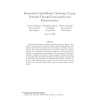Free Online Productivity Tools
i2Speak
i2Symbol
i2OCR
iTex2Img
iWeb2Print
iWeb2Shot
i2Type
iPdf2Split
iPdf2Merge
i2Bopomofo
i2Arabic
i2Style
i2Image
i2PDF
iLatex2Rtf
Sci2ools
KDD
2002
ACM
2002
ACM
Hierarchical model-based clustering of large datasets through fractionation and refractionation
The goal of clustering is to identify distinct groups in a dataset. Compared to non-parametric clustering methods like complete linkage, hierarchical model-based clustering has the advantage of offering a way to estimate the number of groups present in the data. However, its computational cost is quadratic in the number of items to be clustered, and it is therefore not applicable to large problems. We review an idea called Fractionation, originally conceived by Cutting, Karger, Pedersen and Tukey for non-parametric hierarchical clustering of large datasets, and describe an adaptation of Fractionation to model-based clustering. A further extension, called Refractionation, leads to a procedure that can be successful even in the difficult situation where there are large numbers of small groups. Supported by NSA grant 62-1942. Supported by NSF grant DMS-9803226 and NSA grant 62-194 2. 1
Data Mining | Hierarchical Model-based Clustering | KDD 2002 | Non-parametric Clustering Methods | Non-parametric Hierarchical Clustering |
| Added | 30 Nov 2009 |
| Updated | 30 Nov 2009 |
| Type | Conference |
| Year | 2002 |
| Where | KDD |
| Authors | Jeremy Tantrum, Alejandro Murua, Werner Stuetzle |
Comments (0)

